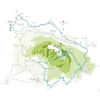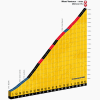The race sets off from Vaison-la-Romaine, a place northwest of the Mont Ventoux. The fastest route to the summit is 30 kilometres long, but instead the riders circle around the Bald Mountain in a big and awe-inspiring loop.
The loop features the gentle warm-up climb on the Col de Fontaube after 20 kilometres. The ascent is 10 kilometres long, the first half of which is merely a false flat and the second half goes up at 4 to 5%.
The route continues in a clockwise direction along the flanks of Mont Ventoux before the first ascent begins in Bédoin. The road until Chalet Reynard is 10 kilometres long and the average gradient sits at 9%. At the intersection the riders turn right and fly down the mountain into Sault. On the same roads as before they return to Bédoin.
Beginning from Bédoin the ascent is 20.8 kilometres long with an average gradient of 7.5%. The first kilometres are relatively easy, but after Les Bruns the riders enter the forest and a section of 3 kilometres at 10%. The slope hardly drops below 8% during the length of the ride through the forest.
After Chalet Renard the forest gives way to a moon-like scenery. At first the gradient drops to 5%, but this relief is only short-lived. The gradient goes back up again and the last 2 kilometres of Mont Ventoux rise at 9.5%.
If you consider the ascent to begin in Les Bruns the Mont Ventoux is 15.7 kilometres long, while its average gradient sits at 8.8%.
The 1st edition of the Mont Ventoux Dénivelé Challenge came down to a clash between Romain Bardet and Jesús Herrada. The French favourite tried to drop his opponent several times, but the Spaniard did not flinch. On the contrary, Herrada attacked in the last 300 metres to win the race 9 seconds ahead of Bardet.
Another interesting read: results/race report 2020 Mont Ventoux Dénivelé Challenge.
Mont Ventoux Dénivelé Challenge 2020: route, profiles
Click on the images to zoom


